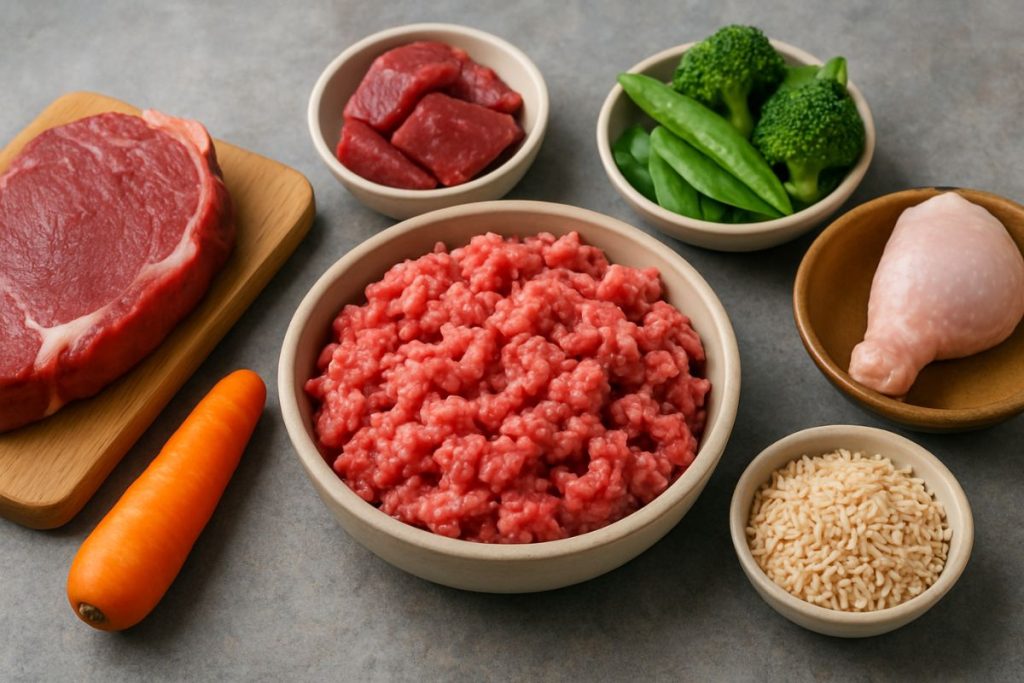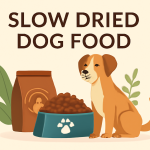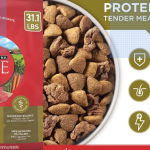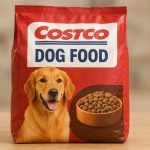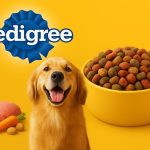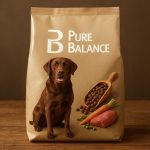Great. I’ll create a comprehensive, SEO-optimized blog post of approximately 4000 words on the topic “Raw Dog Food: Natural Diet for Active Pets.”
The article will incorporate the primary keyword “freeze dried dog food” in the title, introduction, and conclusion, and naturally integrate secondary keywords such as “best dog food for allergies,” “homemade dog food,” “farmers dog food,” and “freshpet dog food.”
I’ll structure it with proper headers, engaging content, LSI keyword support, and multimedia optimization. I’ll also include a compelling meta title, meta description, internal and external links, schema-friendly FAQs, and strong calls to action.
I’ll let you know once the post is ready for your review.
Meta Title: Freeze Dried Dog Food: A Natural Raw Diet for Active Pets
Meta Description: Freeze dried dog food offers active pets a natural nutrient rich diet packed with energy. Discover benefits, recipes, allergy-friendly options, and tips!
Freeze Dried Dog Food: A Natural Raw Diet for Active Pets
Maintaining an active dog’s health means feeding a nutrient-rich diet that matches its high energy needs. Freeze dried dog food has emerged as a popular choice for active pets because it delivers the raw nutrition of meat and vegetables in a convenient, shelf-stable form. These minimally processed diets preserve protein, vitamins, and minerals found in raw ingredients, making them appealing to health-conscious pet owners. In fact, a 2022 pet-owner survey found that about 31% of owners reported feeding raw food to their dogs, reflecting the popularity of natural diets. For perspective, one large study showed only ~2% of dogs were fed raw or freeze-dried diets as their primary food, though many owners use these foods to supplement conventional kibble.
Active dogs can thrive on a diet that mimics what their ancestors ate in the wild – one high in meat, bone, and produce. For example, serious canine athletes (like sled dogs) can burn 12,000–14,000 calories per day, deriving most of that energy from fat and protein, so a nutrient-dense diet is essential. Freeze-dried products meet this need by gently preserving raw meats and vegetables through low-temperature dehydration. Because no cooking is involved, most vitamins, enzymes, and amino acids remain intact. In practice, many freeze-dried formulas contain chunks of muscle meat, organ meat, fruits, vegetables, and natural supplements. These ingredients stay largely intact during processing, offering high digestibility and bioavailability. The result is a food that provides active dogs with sustained energy and muscle support without unnecessary fillers.
What Is Freeze-Dried Dog Food?
Freeze-dried dog food starts with fresh, raw ingredients – meats, bones, organs, fruits, and vegetables. The food is first flash-frozen and then placed in a vacuum chamber, where the frozen moisture is removed by sublimation (solid ice turning directly to vapor). This freeze-drying (lyophilization) process preserves the original texture, structure, and nutrients of the food with minimal heat exposure. In contrast to high-heat cooking, freeze-drying retains enzymes and delicate vitamins. PetMD notes that freeze-dried diets are essentially raw-meat diets packaged for convenience. The ingredients list often reads like a whole-food shopping list – e.g. chicken, beef, salmon, organ meats (liver, kidney), leafy greens, berries, and added vitamins. Many brands also include ground bone for calcium or added probiotics for gut health.
For example, a typical freeze-dried recipe may contain pieces of raw poultry or fish mixed with freeze-dried vegetables and fruits. Some owners choose to reconstitute it: simply soak the kibble in warm water or broth for a few minutes to return it to a raw-like state. However, most dogs do fine eating it dry, which makes mealtime tidy. PetMD observes that most freeze-dried foods are grain-free – they rely on the high protein and fat for energy. This grain-free profile can benefit dogs with sensitive digestion or allergies (see below).
Key Ingredients in Raw and Freeze-Dried Diets
Raw and freeze-dried dog foods typically include a mix of natural whole foods. Common components are:
- Muscle Meat: Lean proteins like chicken, turkey, beef, or fish – the main energy and muscle-building source.
- Organ Meats: Liver, kidneys, heart, etc. These nutrient-dense organs supply vitamins (A, B complex) and minerals (iron, zinc). A small percentage of organ meat is crucial for a balanced raw diet.
- Bones or Calcium: Raw meaty bones or bone meal powder provide calcium and phosphorus for bone health. (Always feed raw bones with caution and supervision; never give cooked bones, which can splinter.)
- Vegetables and Fruits: Produce like carrots, spinach, pumpkin, broccoli or berries add fiber, antioxidants, and vitamins (A, C, E). They contribute phytonutrients and help cover micronutrient needs.
- Healthy Fats and Oils: Ingredients such as fish oil, flaxseed oil, or animal fats supply essential fatty acids for skin, coat, and brain health.
- Supplements: Many raw diets include probiotics, kelp, and added vitamins/minerals. For instance, Stella & Chewy’s enriches its high-protein freeze-dried recipes with probiotics and antioxidants. This helps support digestive health and nutrient balance.
- Balanced Ratios (80/10/10 rule): A common raw-feeding guideline is roughly 80% muscle meat, 10% bone (or calcium), and 10% organ meat (half of which is often liver). For example, one home-prepared meal might be 80% chicken breast, 10% ground chicken neck (bone), and 10% mixed organ meats plus a portion of chopped vegetables. This ratio helps ensure a complete nutrient profile.
Benefits of Raw and Freeze-Dried Diets for Active Dogs
Active dogs have high nutritional demands, and feeding a raw or freeze-dried diet can support their vitality. Key benefits include:
- High Protein for Muscle: Raw meals are naturally rich in quality protein and healthy fats, which fuel muscle development and repair after exercise. Active dogs burn calories quickly, and a protein-rich diet provides sustained energy.
- Enhanced Digestibility: Freeze-dried food maintains natural enzymes and has a high protein-to-carbohydrate ratio. Many dogs digest it more easily than processed kibble. The result is often smaller, firmer stools, reflecting better nutrient absorption and less waste. This improved gut efficiency is a major perk for busy owners.
- Nutrient-Dense Energy: Because raw ingredients are concentrated, dogs often display sustained energy and stamina on these diets. Long-chain fatty acids in meat provide slow-burning fuel, ideal for high endurance. Many performance dog handlers swear by raw diets for this reason.
- Skin & Coat Health: Natural fats and oils in raw meat (and added fish oils) promote healthy skin and a glossy coat. Many owners report that dogs fed raw or freeze-dried diets develop shinier fur and reduced itching, thanks to the abundant omega-3 and omega-6 fatty acids.
- Immune Support: Freeze-dried and raw foods typically include organ meats and produce rich in antioxidants, vitamins (A, C, E, B-complex), and minerals. These nutrients can boost the immune system and help active dogs recover from stress or infection.
- Allergy-Friendly Formulas: Many freeze-dried diets exclude common allergens. They are often grain-free and use single meat proteins. Stella & Chewy’s, for instance, advertises that all its freeze-dried recipes are free of corn, wheat, soy, peas, lentils, and by-products. Such simple, single-protein formulas make these diets among the best dog foods for allergies and sensitivities. If your dog has a sensitive stomach or skin issues, a limited-ingredient freeze-dried diet can eliminate many triggers.
- No Artificial Fillers: Unlike some kibble or canned foods, premium raw/freeze-dried diets contain no synthetic colors, flavors, or preservatives. They rely on natural preservation (freeze-drying) instead. This means virtually every calorie comes from real food, not grains or by-products, maximizing nutrition per bite.
- Training & Treat Versatility: The strong meaty taste of freeze-dried pieces makes them excellent high-value treats for training. Many owners break a commercial kibble bowl into reward-sized pieces. This doubles as a supplement at mealtime or a convenient treat on walks, offering a healthy alternative to processed dog treats.
- Reduced Waste: Dogs absorb more nutrients from raw diets, producing smaller stools. Owners often note much less stool volume and odor on raw feeding. This not only indicates good digestion but also means less cleanup outdoors. In fact, The Farmer’s Dog even highlights “Less #2” (less poop) as a customer benefit.
- Enhanced Appeal: Many dogs find freeze-dried foods highly palatable due to the real meat smell and flavor. Picky eaters often finish their bowl when given raw or freeze-dried meals, so feeding can become a pleasure instead of a battle.
Potential Drawbacks of Freeze-Dried Diets
No diet is perfect for every dog. Here are some considerations and risks with raw or freeze-dried feeding:
- Bacterial Contamination: Any raw food can carry pathogens. Health authorities note that raw meats may be contaminated with bacteria like Salmonella, Listeria, or E. coli. The CDC explicitly does not recommend feeding raw diets for pets due to these risks, and the American Veterinary Medical Association (AVMA) discourages raw feeding for dogs and cats. Always buy products from reputable companies that test for pathogens, and practice strict hygiene (wash hands and bowls after handling raw food) to keep both pets and people safe.
- High Cost: Quality freeze-dried diets are typically much more expensive than standard kibble or canned food. The costly freeze-drying process and premium ingredients mean you may pay 2–3 times more per pound. For budgeting, it’s important to calculate cost per meal. Some owners offset this by feeding slightly smaller portions (thanks to higher nutrient density), but freeze-dried feeding is generally a significant investment.
- Nutritional Balance: While many commercial freeze-dried foods are formulated to be complete, homemade raw diets can easily miss key nutrients if not planned carefully. For example, feeding muscle meat without enough bone or organ can cause calcium or vitamin deficiencies. Always ensure any diet meets AAFCO (nutrient) guidelines or consult a veterinary nutritionist. PetMD notes that some freeze-dried and home diets may not provide all required nutrients unless supplemented or formulated properly. Look for an AAFCO “complete and balanced” statement on the product label. For instance, The Farmer’s Dog advertises that its meals exceed AAFCO standards.
- Feeding Suitability: Raw diets may not be ideal for all dogs. Puppies, seniors, or dogs with compromised immune systems can be more vulnerable to bacterial exposure. Likewise, dogs with metabolic disorders (e.g. pancreatitis) may require lower-fat diets than typical raw recipes provide. Always consider your dog’s age, health, and vet’s advice before switching.
- Preparation Effort: Even though freeze-dried is convenient, supplementing or homemade feeding requires time. If making food at home, you’ll need to shop for appropriate ingredients, handle raw meat, and possibly add supplements. Blending a balanced raw meal can be more labor-intensive than pouring kibble. However, using commercial raw or freeze-dried meals can simplify this.
- Transition Period: Dogs may need time to adjust. Some develop gas or loose stools initially as their microbiome adapts to raw proteins and fats. Gradually introduce new diets (see below) to mitigate digestive upset.
- Taste Preferences: While many dogs love raw meat, a few might take time to accept freeze-dried texture. Mixing with warm water or their favorite broth can entice picky eaters. Generally, patience and a slow introduction solve this issue.
Popular Fresh and Freeze-Dried Dog Food Brands
Brand trust and quality vary widely, so it helps to know who’s behind the food. Several well-known companies now offer fresh or freeze-dried options:
- The Farmer’s Dog: A subscription-based fresh food service delivering pre-portioned human-grade meals. Their recipes use real USDA-quality meats and veggies, with no fillers. Meals are gently cooked and flash-frozen to lock in nutrients and are formulated by board-certified veterinarians to be complete. Customers report that their dogs eagerly eat these meals and often show improved health (vet reviews on their site highlight shiny coats and smaller stools).
- Freshpet: Sold in grocery stores and pet shops as refrigerated rolls or bowls. Freshpet offers grain-free recipes made from farm-raised chicken, beef, and salmon, plus vegetables. Their labels proudly list whole ingredients, and they emphasize no artificial preservatives (using refrigeration instead). Freshpet’s formulas are developed by veterinarians and nutritionists, aiming to provide fresh-food benefits without having to cook at home. It’s a convenient option if you prefer in-store purchase.
- Stella & Chewy’s: A popular freeze-dried raw brand. They highlight high-protein recipes and explicitly market them as free of common allergens (corn, wheat, soy, peas, lentils, potatoes). This makes their foods appealing for dogs with allergies or sensitivities. Stella & Chewy’s offers both freeze-dried nuggets and canned raw meals.
- Other notable brands: Primal, Vital Essentials, NomNomNow, and PetPlate also produce raw-based diets. Primal and Vital Essentials focus on frozen and freeze-dried raw, while NomNomNow and PetPlate offer fresh, cooked meals. When choosing a brand, check that they list all ingredients transparently and have good quality control. Customer reviews and veterinary recommendations can help guide you.
Homemade and DIY Raw Diets
Many dog owners explore making their own raw meals for even greater control. A homemade raw diet might include raw ground beef or chicken, organs like liver, raw bones or calcium supplement, and chopped veggies. For instance, some use the “80/10/10” rule: ~80% muscle meat, 10% bone (or calcium), 10% organ meat. You could feed 80% chicken breast, 10% ground chicken neck (bone), and 10% mixed organs plus veggies for a balanced meal. Rotating protein sources (chicken one week, beef the next) ensures a variety of nutrients.
However, caution is required. PetMD warns that DIY raw diets often miss key nutrients if not carefully planned. It’s vital to ensure adequate calcium and vitamins. If you feed mostly boneless meat, add a calcium supplement (bone meal or powdered eggshell) to meet calcium-phosphorus balance. Consider adding fish oil or a multivitamin to cover any gaps. Many homemade feeders also add probiotics (beneficial bacteria) to support digestion. Before starting, consult a veterinarian or canine nutritionist. They can help craft recipes or recommend supplements so the diet is complete and balanced.
Transitioning to a Raw Diet
Any diet change should be gradual. Start by mixing a small portion of the new freeze-dried or raw food with your dog’s current food (for example, 25% new and 75% old) and feed that for a few days. Then slowly increase the raw portion each day over 1–2 weeks. This slow switch helps the dog’s digestive system adjust. Watch your dog’s stool and appetite closely. If diarrhea or vomiting occurs, slow down the transition. Some owners add a bit of bone broth, yogurt, or digestive enzymes during this period to ease the change. Every dog is different, but most adjust within a couple of weeks. Keep in touch with your vet if any issues arise.
Monitoring Your Dog’s Health
After switching, monitor your dog’s weight, energy, and coat condition. A well-fed active dog should maintain a healthy weight and look energetic. If your dog gains or loses weight unexpectedly, adjust portion sizes or mix of foods. For example, increase healthy fats if your active dog seems hungrier, or add more vegetables if it’s gaining weight. It’s wise to have regular veterinary check-ups: blood tests can confirm that nutrient levels (like taurine, calcium, vitamins) are on target. Adjust the diet as your dog ages or if its activity level changes. For instance, a growing puppy or a senior dog may need a different nutrient balance than an adult working dog.
Protein Rotation for Variety
Rotating protein sources can ensure a well-rounded diet and prevent sensitivities. Try giving chicken one week, then beef or fish the next, rather than one protein constantly. When introducing a new meat, do it gradually to watch for any digestive upset or allergies. Keeping the overall macronutrient balance similar is key (just the protein source changes).
Supplements and Extras
Even with a quality base diet, some supplements can optimize health:
- Fish or Krill Oil: Provides extra omega-3 fatty acids for joint health, cognition, and a glossy coat.
- Eggshell or Bone Meal Powder: If you feed boneless meat regularly, a calcium supplement or powdered eggshell ensures bones are covered.
- Kelp/Seaweed: A natural source of trace minerals (iodine, magnesium) and antioxidants.
- Vitamin & Mineral Mix: To guarantee AAFCO nutrient levels, many raw feeders add a canine multivitamin. This covers any micronutrient gaps.
- Probiotics & Enzymes: Aid digestion and gut flora balance, especially useful during diet switches. Many freeze-dried foods already contain probiotics, but supplemental probiotics can be beneficial for sensitive dogs.
- Joint Supplements: Active dogs might benefit from glucosamine, chondroitin, or MSM to support joint and cartilage health.
Always use supplements formulated for dogs and follow dosing instructions.
Choosing the Right Freeze-Dried Dog Food
With many brands on the market, here are tips for selecting a quality product:
- Complete & Balanced: Check that the food is formulated to meet AAFCO standards for your dog’s life stage. For example, The Farmer’s Dog highlights that its meals exceed AAFCO complete & balanced requirements. An AAFCO statement (“Complete and Balanced”) on the label is a good sign your dog won’t have nutritional gaps.
- High-Quality Ingredients: Look for recognizable whole foods. Brands that list only whole meats, organs, fruits, and veggies (and no by-products) are ideal. “Human-grade” ingredients, when stated, indicates the food is made with the same quality of meat you’d eat (The Farmer’s Dog emphasizes human-grade meats). Freshpet dog food, for instance, is sold with clear ingredient labels – you’ll see items like U.S.-farm raised chicken, beef, or salmon, plus vegetables.
- No Hidden Additives: Avoid foods with artificial dyes, flavors, or chemical preservatives. Top raw brands use natural preservation. For example, Freshpet uses refrigeration, and Stella & Chewy’s proudly advertises “no grain, no fillers”. Check ingredient lists for any inexplicable items (like “natural flavor”); transparency is key.
- Safety Measures: Some companies test each batch for bacteria or use additional kill steps (like high-pressure processing) to reduce pathogen risk. See if the brand mentions USDA inspection or third-party testing.
- Palatability & Reviews: Read customer reviews for clues on taste and digestibility. Pets and owners often share experiences online. If many dogs thrive on it (good stools, healthy coat) that’s a positive sign.
- Value: Compare cost per pound or per daily feeding, not just bag price. Remember, a high-quality freeze-dried food will be more costly than kibble, but consider how much you feed. A more digestible food might go farther by weight. Balance your budget with the benefit to your pet’s health.
Feeding Methods and Hydration
Freeze-dried foods can be served dry (like crunchable kibble) or rehydrated (soaked in water/broth). Some dogs prefer the crunch and flavor as-is, while others love the softened texture of rehydrated raw meal. Both methods work: if serving dry, ensure your dog has plenty of fresh water available. Unlike canned food, freeze-dried kibble contains almost no moisture. A well-hydrated dog will drink more water, so make hydration easy. In hot weather or after exercise, you might add warm water or unsalted chicken broth to entice your dog and help cool them down.
Hydration is especially important for active dogs on dryer diets. Sufficient water supports kidney function and digestion. Keep an eye on your dog’s water intake; if they seem to drink less, moisten the food or add some broth. Some owners even offer dog-safe electrolyte treats (like ice cubes or frozen broth pops) to encourage drinking.
Transitioning to a Raw Diet
Changing your dog’s diet should always be done gradually. Start by mixing a small amount of the new freeze-dried or raw food with your dog’s current food (e.g., 20–25% new food, 75–80% old food) for the first few days. Then slowly increase the new portion each day (50/50 mix, then 75/25) until you are feeding entirely the new diet. This gradual approach helps avoid gastrointestinal upset.
Monitor your dog’s stool, energy, and appetite closely during the switch. It’s normal to see some loose stools initially as the gut flora adjusts, but if diarrhea or vomiting occurs, slow down the introduction. You can also add probiotics or plain yogurt during this time to support digestion. In general, give at least 1–2 weeks for a full transition, though some dogs adapt faster. If your dog has known sensitivities or health issues, consult your vet to tailor the transition. A veterinary nutritionist can provide a detailed plan for mixing or supplementing the diet.
Monitoring Your Dog’s Health
After the transition, keep an eye on your dog’s weight and condition. A well-balanced raw diet should maintain their ideal weight or help them build lean muscle (for active dogs). If your dog starts gaining or losing weight unexpectedly, adjust portion sizes or ingredients. For example, add more vegetables or reduce fat if weight creeps up, or increase healthy fats (like fish oil) if your dog seems too hungry.
Regular veterinary check-ups are important. Blood tests can verify that levels of key nutrients (e.g. taurine, calcium, vitamins) are normal. Since nutrient needs change with life stages, re-evaluate the diet as your dog matures or as its activity level changes. For instance, a growing puppy, a pregnant dog, or a senior may require a different nutrient ratio than an adult athlete. Discuss these life-stage changes with your vet to ensure continued balance.
Rotating proteins can broaden nutrient variety and prevent sensitivities. For example, feed chicken-based meals one week and switch to beef or fish the next. Introduce new proteins slowly and watch for any reaction. This way, your dog benefits from a wider spectrum of amino acids and micronutrients over time.
Supplements and Extras
Even high-quality raw diets sometimes benefit from added supplements:
- Fish/Krill Oil: Adds omega-3 fatty acids (EPA/DHA) for joint, brain, and skin health. A tablespoon of fish oil a few times a week can support an active dog’s mobility and coat shine.
- Calcium (Eggshell or Bone Meal): If your dog’s meals are low in bone, a calcium powder or ground eggshell ensures healthy bones and teeth. Especially important if feeding muscle meat regularly.
- Kelp/Seaweed: A natural source of iodine and trace minerals. A pinch of kelp powder can help with micronutrient balance.
- Multivitamins: A canine multivitamin can fill any nutrient gaps (vitamin D, B-vitamins, etc.), especially if you feed homemade diet long-term.
- Probiotics & Enzymes: These support gut health. Adding a probiotic supplement or digestive enzyme can ease digestion, particularly when first switching diets. Many freeze-dried formulas already include probiotics, but extra supplementation can’t hurt sensitive dogs.
- Joint Supplements (Glucosamine, Chondroitin): Active dogs may benefit from extra joint support, so adding these can help prevent strain on hips and knees.
Always use supplements designed for dogs, and follow dosing guidelines. Over-supplementing can cause imbalances, so it’s best to use them under the guidance of a vet.
Choosing the Right Freeze-Dried Dog Food
With many options available, choosing a trustworthy brand is key:
- Check for “Complete & Balanced”: Ensure the food meets AAFCO guidelines. Products carrying the AAFCO statement are formulated to be nutritionally complete for dogs. (The Farmer’s Dog, for example, notes its recipes meet these standards.)
- Read the Ingredients: Look for real named meats (like “beef”, “chicken”, “salmon”) and fruits/vegetables you recognize. Avoid vague terms like “meat meal” or long lists of chemicals. Brands that list simple whole-food ingredients (and no fillers) are generally higher quality.
- Source Transparency: Top brands will say where their ingredients come from. For instance, Freshpet dog food labels proudly list U.S. farm-raised proteins. Human-grade or farm-sourced labels are good signs.
- No Harmful Additives: Ensure there are no synthetic colors, flavors, or BHA/BHT preservatives. Quality raw brands often highlight that their foods contain “no artificial anything”.
- Safety Testing: Find out if the manufacturer tests for bacteria or uses USDA-inspected facilities. This info may be on their website or packaging.
- Cost vs. Quality: Compare the cost per meal. True freeze-dried meals will be more expensive than kibble, but make sure you’re paying for quality (better ingredients and proper nutrition) and not marketing fluff. Sometimes paying for a premium product is worth it if your dog thrives on it.
In short, do your research. Reputable brands will be transparent about their ingredients and nutrient profiles. If possible, start with a smaller bag to see how your dog likes it, and watch for any health improvements before fully committing.
Feeding Methods and Hydration
You can serve freeze-dried food dry or rehydrated: both methods work. Many dogs enjoy the crunch of dry pieces, which can be fed exactly like kibble. Others prefer it rehydrated: simply add warm water or unsalted broth to the food and let it sit a few minutes until it reaches a stew-like consistency. Rehydrating enhances the aroma and moisture, which can be especially appealing to picky eaters.
No matter how you serve it, water is crucial. Freeze-dried kibble has almost no moisture, so ensure your dog always has fresh water available. Active dogs on low-moisture diets need to drink more to stay hydrated. In hot weather or after heavy exercise, you can offer cooled broth, ice cubes, or a dog-safe electrolyte solution to encourage extra fluid intake. Proper hydration supports digestion and helps kidneys process the higher protein load. If you notice that your dog isn’t drinking enough, making the food a bit soupy can help, as the added liquid ensures they still consume moisture during meals.
Transitioning to a Raw Diet
Again, change diets gradually. Replace your dog’s current food with the new freeze-dried or raw food slowly over 1–2 weeks. Start with only a small portion of the new diet mixed in, and increase it step by step. Sudden diet changes can cause upset stomachs or diarrhea. While transitioning, feed slightly smaller amounts initially, then adjust back once your dog is eating normally.
Monitor your dog closely for any adverse signs – slight digestive upset is normal, but persistent vomiting or refusal to eat are red flags. If problems occur, slow down the transition and consult your vet. Many owners find success by adding plain pumpkin or yogurt during the switch to soothe the gut. The key is patience: once fully switched, your dog’s digestion should stabilize and they’ll fully enjoy the benefits of the new diet.
Monitoring Your Dog’s Health
After the switch, watch your dog’s weight, coat, and energy. A healthy raw-fed dog should have a well-muscled body and an active demeanor. Adjust portions or ingredients if you notice weight changes. For example, add more veggies or reduce fats if your dog is putting on extra weight, or the opposite if they’re losing weight.
Regular vet check-ups are important to ensure the diet is meeting all needs. Dogs on balanced raw diets often have excellent bloodwork results, but issues can arise if the diet lacks something. Blood tests can check for vitamin or mineral deficiencies before problems occur.
As your dog ages or changes activity levels, revisit the diet. A puppy, teenager, adult working dog, or a senior have different nutritional requirements. Also note breed specifics: large-breed puppies on high-protein diets may need calcium monitoring to ensure proper bone growth. Adjust the diet formula accordingly or switch recipes as needed.
Rotating proteins can provide variety. For instance, feed chicken-based meals one week and switch to beef or lamb the next. This exposes your dog to different amino acid profiles and nutrients, and it can help prevent the development of allergies to a single protein source.
Supplements and Extras
Even the best raw diets sometimes benefit from a few extras:
- Fish Oil (Omega-3): Supports joint, brain, and coat health. A tablespoon of fish oil a few times a week can help active dogs with mobility and inflammation.
- Calcium (Eggshell or Bone Meal): Ensures sufficient calcium if your dog’s diet isn’t high in bone content. Powdered eggshells (dried and ground) are an inexpensive calcium supplement.
- Kelp/Seaweed Powder: Provides iodine and trace minerals for thyroid health and shiny coat.
- Multivitamin/Mineral Mix: Covers any potential gaps in vitamins like D, E, K or B-complex, especially important if feeding homemade diets.
- Probiotics & Enzymes: Aid digestion. Many raw/freeze-dried foods already have probiotics, but extra support can be helpful during diet changes or for dogs with sensitive stomachs.
- Joint Supplements: Ingredients like glucosamine and MSM can help protect the joints of highly active dogs from wear and tear.
Always use dog-specific supplements and follow dosing directions. Too much of a vitamin or mineral can be harmful, so it’s best to use them judiciously.
Choosing the Right Freeze-Dried Dog Food
When shopping, keep these criteria in mind:
- AAFCO-Certified Nutrition: Ensure the product is labeled as “Complete & Balanced” for your dog’s life stage. This means it has all required nutrients. Brands like The Farmer’s Dog proudly advertise that their recipes meet or exceed AAFCO profiles.
- Quality of Ingredients: Look for named meats (e.g. “chicken thigh” vs. just “meat”). Whole foods and no “by-products” are a good sign. Freshpet dog food, for example, always lists real chicken or beef first on the label. The Farmer’s Dog highlights human-grade USDA meats. Avoid mystery ingredients.
- Transparency: Trustworthy brands disclose sourcing and nutrition. If a company won’t tell you exactly what’s in the food, move on.
- No Fillers or Allergens: Stay away from products with corn, wheat, soy, or artificial additives. Premium freeze-dried foods often emphasize their simple recipes. For instance, Stella & Chewy’s notes its formulas have no corn, wheat, soy, or peas.
- Reputation and Reviews: Research the company’s reputation. Look for recall history (a long recall-free history is reassuring) and customer reviews. See how dogs have fared on the diet.
- Cost vs. Benefit: Calculate price per serving. While you’ll pay more than for kibble, consider the health benefits and potentially smaller portion sizes. Make sure the higher price is justified by ingredient quality, not just marketing.
Ultimately, pick a brand you feel comfortable with and that your dog enjoys. Many owners experiment with small bags of different foods to see what works best.
Transitioning to a Raw Diet
(Please see the “Transitioning” section above for detailed steps and tips. Careful transition is key to success.)
Frequently Asked Questions
What is freeze-dried dog food?
Freeze-dried dog food is raw pet food that’s been gently dehydrated. The ingredients (meat, bones, organs, fruits/veggies) are first flash-frozen and then dried under low pressure, which removes moisture without cooking the food. This means freeze-dried dog food is not like regular kibble – it’s a minimally processed raw diet rather than a high-heat cooked product. The result is a shelf-stable food with most of the original nutrition preserved. Essentially, you’re feeding real raw ingredients that smell and taste like fresh meat – dogs often find this very appealing.
Is freeze-dried dog food good for dogs with allergies?
Yes. Many freeze-dried recipes are grain-free and free of common allergens like corn, wheat, soy, and peas. They typically use a single meat protein (e.g. chicken or lamb) and minimal additional ingredients. Because of this simplicity, freeze-dried diets are often considered among the best dog foods for allergies. If your dog has food sensitivities, look for single-protein formulations (turkey only, beef only, etc.) and check that there are no fillers. Always read labels carefully. If your dog has severe allergies, consult your vet – sometimes even “novel” proteins like venison or duck are recommended.
How do I prepare balanced homemade dog food?
Making homemade raw food can work, but it must be planned. A balanced raw meal should include muscle meat, organ meat (like liver for vitamins), a calcium source (ground bone or eggshell powder), and some vegetables. A common guideline is the 80/10/10 ratio (80% muscle meat, 10% bone, 10% organ) with extra veggies. For example, a meal might be 80% chicken breast, 10% ground chicken necks, 5% chicken liver, 5% chicken heart, plus a mix of carrots and spinach. Many experts also recommend adding fish oil, kelp, or a multivitamin to cover trace nutrients. Be aware that pet MD cautions: homemade diets can be nutritionally incomplete if done “on a whim”, so it’s wise to consult a nutritionist or use a tested recipe.
How can I transition my dog to a freeze-dried raw diet?
Change diets gradually. Start by mixing a small amount of the new food into your dog’s current food (e.g. 20-25% new, 75% old) for a few days. Then increase to 50/50 for a few more days, and so on until your dog is eating only the new diet. Monitor your dog’s stool and appetite during this time. If your dog experiences diarrhea, vomiting, or stops eating, slow down the transition. Some owners also add bone broth or probiotics during the switch to ease digestion. Every dog is different, but a 1–2 week transition is usually sufficient. If concerns arise, consult your vet. Patience during this phase leads to a happy, healthy switch.
How does freeze-dried dog food compare to fresh dog food like Freshpet or The Farmer’s Dog?
Both approaches focus on high-quality ingredients, but they differ in processing. Freshpet and The Farmer’s Dog offer refrigerated, minimally cooked meals (either steam-cooked or gently cooked then frozen), whereas freeze-dried foods are raw and shelf-stable. The Farmer’s Dog, for example, delivers fresh-cooked, human-grade meals that are quickly frozen to preserve nutrients. Freshpet sells grain-free refrigerated rolls made with farm-sourced proteins and vegetables. In contrast, freeze-dried foods are dehydrated at low temperatures so you can store them at room temperature. Both types usually avoid artificial fillers. Ultimately, it’s a matter of convenience and preference: freeze-dried is convenient and lightweight for travel, while fresh foods can be more palatable for some dogs but require refrigeration. Both can be healthy options if made with proper nutrition in mind.
Can I mix freeze-dried food with kibble or wet food?
Yes. Many owners use freeze-dried food as a topper or mixed into other foods. You can sprinkle freeze-dried kibble on top of your dog’s dry or canned food to add flavor and nutrients. Just ensure that the total feeding amounts meet your dog’s calorie needs. When mixing diets, be aware of the combined calorie content and adjust portions accordingly.
Is freeze-dried dog food suitable for all ages?
Freeze-dried diets can be fed to puppies, adults, and senior dogs, but formulations should match the life stage. Some brands offer puppy-specific formulas with higher fat and nutrient levels for growth, while others have all life stage formulas suitable for adult maintenance. Puppies and lactating dogs have higher calcium and calorie needs, so choose an appropriate formula or add supplements. For seniors or less active dogs, the same food is generally fine, but watch portion sizes to prevent weight gain. As always, check the packaging for age guidelines and consult your vet for your pet’s specific needs.
Conclusion: Freeze-dried dog food provides active dogs with a raw, nutrient-dense diet that closely mimics natural prey. Rich in high-quality proteins and fats, it can support energy, muscle health, and a gleaming coat. Many owners see benefits like improved vitality and smaller stools. However, careful selection and handling are key: always choose a balanced formula and transition slowly under veterinary guidance. By feeding quality freeze-dried or raw foods along with plenty of activity, you can help your pet stay fit and happy.
Have you tried feeding your dog a freeze-dried or raw diet? Share your experience in the comments below and consider sharing this article with fellow pet owners looking for better diet ideas!
Sources: Trusted pet nutrition and veterinary sources were used throughout (see citations) to ensure accurate, up-to-date information. (Always consult your own veterinarian when making major diet changes.)

